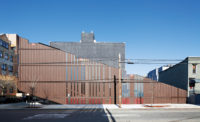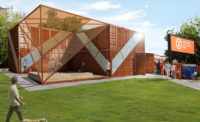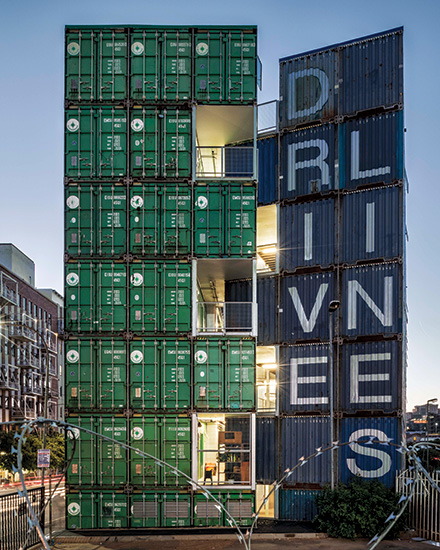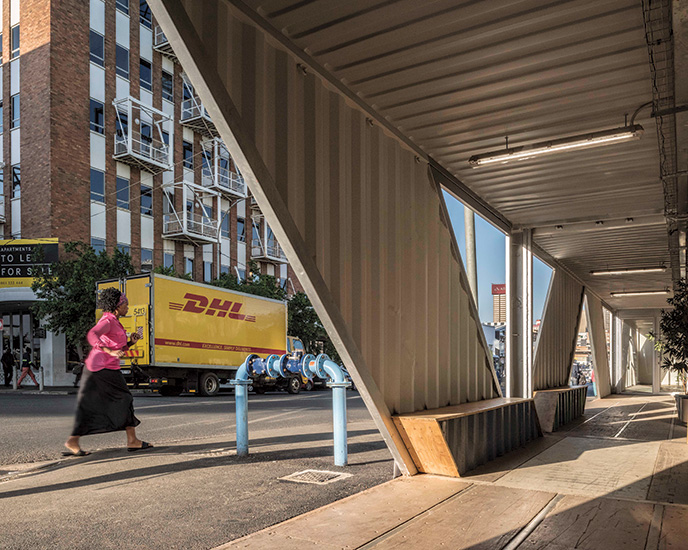Drivelines by LOT-EK
Johannesburg

Drivelines is the largest residential shipping-container development in South Africa.
Photo © Dave Southwood

Generous walkways act as balconies.
Photo © Dave Southwood

Drivelines is a towering presence in Maboneng.
Photo © Dave Southwood

Its graphic facade serves as a backdrop at the end of a busy road.
Photo © Dave Southwood

The containers’ diagonal bracing dictated very simple and efficient fenestration cuts.
Photo © Dave Southwood

A covered portico with benches connects to the street.
Photo © Dave Southwood

The upcycled shipping containers are transformed into simple dwellings.
Photo © Dave Southwood

The upcycled shipping containers are transformed into simple dwellings.
Photo © Dave Southwood

Walkways line the triangular courtyard, which serves as a social space for residents.
Photo © Dave Southwood

Image courtesy LOT-EK










Architects & Firms
Located in the historically, culturally, and economically complex Maboneng precinct in downtown Johannesburg, Drivelines is the largest residential shipping-container development in South Africa, where the type is becoming a popular housing alternative for its affordable and sustainable attributes. The building offers unique rental accommodations while celebrating the beauty of existing objects and everyday activities through its carefully considered design.
Additional Content:
Jump to credits & specifications
Developed by South African company Propertuity and designed by New York–based architecture firm LOT-EK, the 75,000-square-foot project is situated on Albertina Sisulu Road, a prominent arterial that connects the east and west regions of the metropolis. Over the last decade, Maboneng has emerged as a cultural and tourist destination, with Arts on Main and Main Street Life creative hubs the center of a variety of cultural, retail, leisure, small-scale commercial, and mid-income residential offerings. But the precinct has often been criticized as an attempt at gentrification that has excluded the existing community of Jeppestown, an economically disadvantaged area of light industry, characterized by urban decay.
Jonathan Liebmann, Propertuity founder and visionary behind the development of the Maboneng precinct, explains, “Four years after we started work in Maboneng, we decided to focus on delivering affordable residential accommodation in anticipation of market demand. In Maboneng, the average rental has been about the equivalent of $330 per month, but we foresee this decreasing to around $230 over the next couple of years.”
The site, previously home to a small auto-mechanic shop called Drivelines, plays a crucial role in the development of Maboneng, since it extends the northern boundary of the precinct beyond the busy Albertina Sisulu Road. “The primary design informant was the strange triangular shape of the site, with frontage onto a major thoroughfare,” says LOT-EK principal Giuseppe Lignano. “It’s a very strong location, and we had the opportunity to create a backdrop for Maboneng that would function as a billboard for the east and west approaches.”
As a studio, LOT-EK embraces a sustainable approach to construction through upcycling, with an extensive portfolio worldwide centered on the reuse of shipping containers and other industrial objects. This was why Liebmann approached LOT-EK founders Lignano and Ada Tolla.
“As we started working on the design, we immediately thought about combining the residential component with something more collective,” notes Tolla. “We felt that Drivelines could contribute to the surrounding community through a retail component at ground level, which forms a covered portico with benches along the busy street edge and provides a threshold that connects the building to the city. This sense of collective space could then be carried further by hinging the two arms of the building in response to the triangular shape of the site to create an internal courtyard space.”
LOT-EK was motivated by the qualities of light and space and the idea of silence against the noise of a busy road, opening the units to the internal courtyard, and also by the constraints that come from using containers. “We wanted to defy the narrowness of the container, to create wider and more gentle spaces for residential use,” says Tolla. They achieved this by designing two living units—which range in size from 400 to 500 square feet—out of one rectangular assembly of six containers, with a central core for bathrooms, and windows opening to the left and right, allowing the diagonal bracing of the containers to dictate very simple and efficient fenestration cuts in the corrugated container walls.
Designing to the dimensions of containers provided unexpected opportunities to include communal spaces. The generous width of the walkways between the units and the courtyard generated transitional semiprivate hybrid spaces, and the junction of the building’s two arms accommodates stairs and an elevator at a spot that provides narrow framed views and informal meeting points for residents.
As a first for the South African market, the building was not without its challenges. Local companies that supplied the containers did not have the capacity to transform the containers before delivering them, “so we decided to build out the containers on-site. We had not done that before,” says Lignano. “It was a tough process, but everybody pulled together to make it work with a lot of pride, passion, and commitment.”
“The construction process had its own efficiencies,” Tolla adds. “By handling the metalwork on-site, a lot of cut-out material could be reused for reinforcement. Even the little sculptures in the courtyard are the glorified leftovers from the window cutouts. We also decided not to paint the facades, but to source containers of the same color for each arm and allow the rawness of the used objects to be expressed.”
LOT-EK collaborated with local architectural professionals Anita du Plessis and Korine Kruger. “One of our biggest challenges was obtaining approval from the City of Johannesburg fire department,” says du Plessis. “We had to prove it was a rational design alternative in a residential building, where cooking takes place, and demonstrate that we were adequately protecting all structural steel elements in the containers.”
“Much of the experience gained on the project can be explored as a model of living for other contexts,” says Tolla. “The concept is completely exportable—from proposing other ideas of beauty and integrating social spaces, to the use of alternative methods and materials that might be more sustainable.”
“South Africa holds a very important place in the world, from a sociopolitical perspective,” says Lignano. “As regular visitors to Johannesburg, we have watched the evolution of Maboneng and are very proud of this project as a presence in the neighborhood. On a recent visit, it was gratifying to feel that the inhabitants are enjoying daily life in the building. While the original intention was to provide spaces for young people working in the city, we were pleased to see that the studios are flexible enough to accommodate a diversity of tenants of all ages and backgrounds, including young families and retired professionals.”
For Liebmann, the building has surpassed expectations, in terms of both aesthetics and execution. Through its unusual construction methodology, Drivelines pays homage to the industrial nature of Jeppestown and, through its mixed-use and street interface, successfully embeds itself within the urban community.
Watch an exclusive clip of “Upcycle,” a forthcoming documentary about LOT-EK, from producer and director Thomas Piper and executive producer Sherri Wolf.
Visit UpcycleFilm.com for updates.
Video © Thomas Piper/Upcycle
CreditsArchitect: LOT-EK — Ada Tolla, Giuseppe Lignano, principals; Sara Valente, project architect
Associate architect: Anita du Plessis
Engineers: Asakheni, Silman (structural); VBK Engineering Systems, Abbink Consulting (m/e/p)
Consultants: SevenBar Consulting (project management)
General contractor: Tri-Star |
|
















